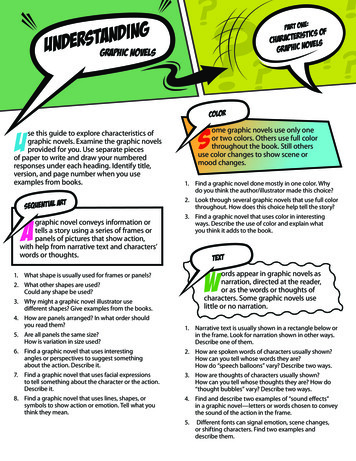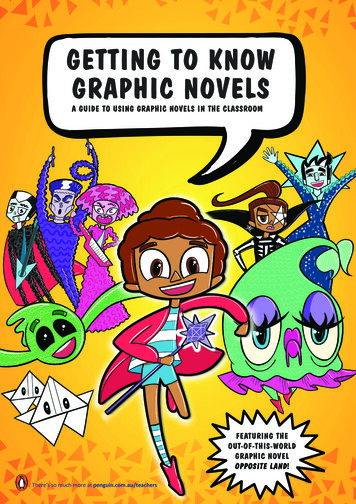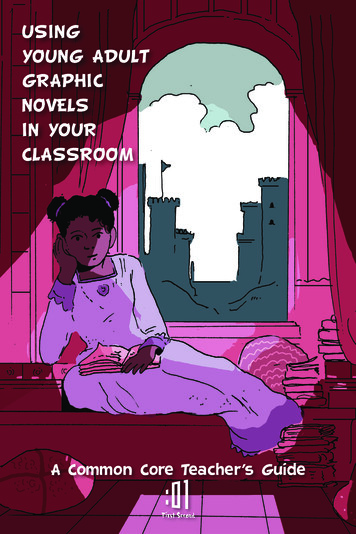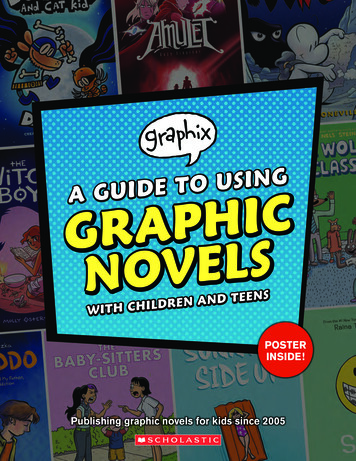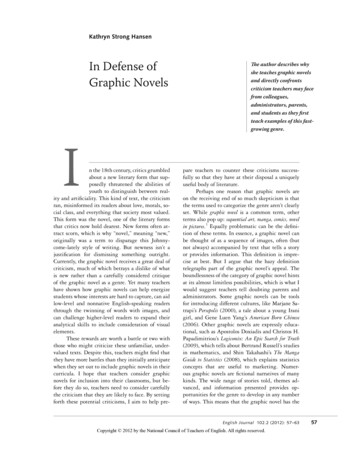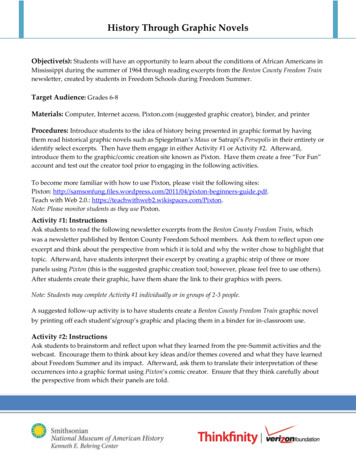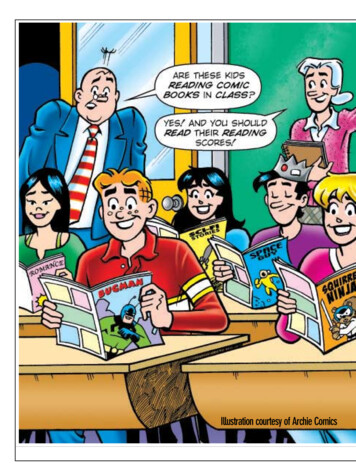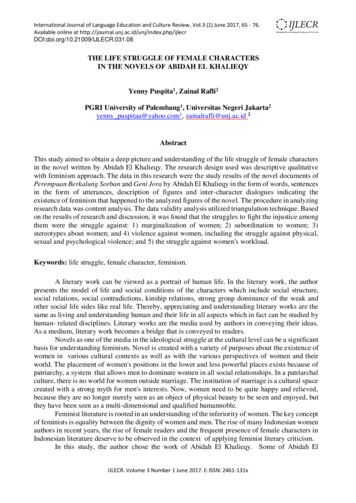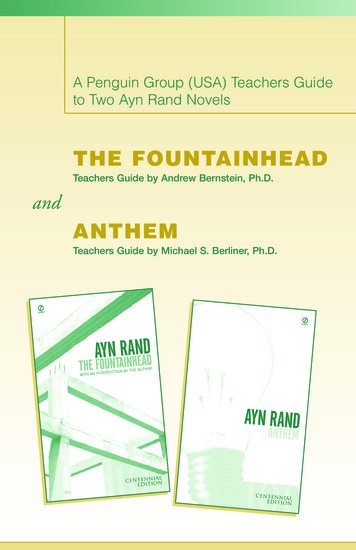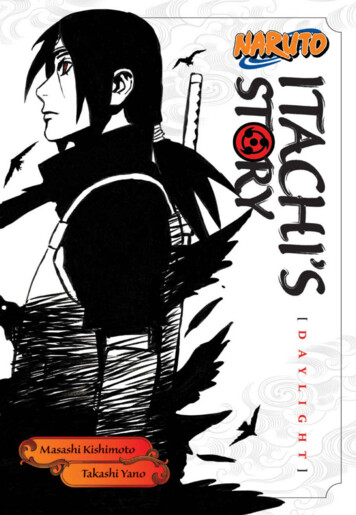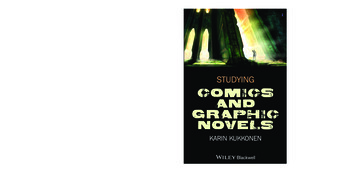
Transcription
KUKKONEN“A much-needed textbook that provides an analytical toolkit to bring to bear on thecomplexities of comics as narrative art and cultural practice. It is both rigorousand reader-friendly: the case-study approach encourages an active application ofthe conceptual framework that is carefully built up. This book is a real asset for allstudents of comics.”Ann Miller, University of Leicester“Karin Kukkonen’s Studying Comics and Graphic Novels provides the reader with thetools necessary to transform themselves quickly from a comics reader to a comicsscholar, capable of engaging graphic narratives from a broad range of approachesand ready to engage in this dynamic and emerging field of study. This is a smartintroduction that takes both its readers and its comics very seriously indeed, whilealways remaining lively and accessible.”Jared Gardner, Ohio State UniversitySTUDYING COMICS AND GRAPHIC NOVELSKARIN KUKKONEN is Balzan PostdoctoralResearch Fellow at St John’s College,University of Oxford. Her research focuses onthe emergence and development of comicsas a narrative form during the twentiethand twenty-first centuries. Dr Kukkonen haspublished work on metaphors, metafiction,and multi-perspective storytelling in comics.Her monograph, Contemporary ComicsStorytelling (forthcoming in 2013) examineshow the comics of recent years engage withthe legacy of postmodernism.STUDYINGCOMICSANDGRAPHICNOVELSKARIN KUKKONENSTUDYINGCOMICSANDGRAPHICNOVELSKARIN KUKKONENToday’s comics and graphic novels tackleserious themes and win Pulitzer prizes.This guide introduces their distinctivecharacteristics, traces their historicaldevelopment, and analyzes their narrativestructure. An ideal course book, the textincludes material on sub-genres, such asautobiography and literary adaptation, anddeploys the principles of cognitive scienceto explore how we respond to texts that fusevisual and linguistic storytelling techniques.Studying Comics and Graphic Novelsincludes study activities, assignments, andessay questions on each topic as well as anextensive glossary and list of prominent comicand graphic novel publications, making this aninvaluable student resource.
Studying Comicsand Graphic Novels
Studying Comicsand Graphic NovelsKarin Kukkonen
This edition first published 2013 2013 John Wiley & Sons, LtdRegistered OfficeJohn Wiley & Sons, Ltd, The Atrium, Southern Gate, Chichester, West Sussex, PO19 8SQ, UKEditorial Offices350 Main Street, Malden, MA 02148-5020, USA9600 Garsington Road, Oxford, OX4 2DQ, UKThe Atrium, Southern Gate, Chichester, West Sussex, PO19 8SQ, UKFor details of our global editorial offices, for customer services, and for information abouthow to apply for permission to reuse the copyright material in this book please see our websiteat www.wiley.com/wiley-blackwell.The right of Karin Kukkonen to be identified as the author of this work has been asserted inaccordance with the UK Copyright, Designs and Patents Act 1988.All rights reserved. No part of this publication may be reproduced, stored in a retrieval system,or transmitted, in any form or by any means, electronic, mechanical, photocopying, recordingor otherwise, except as permitted by the UK Copyright, Designs and Patents Act 1988, withoutthe prior permission of the publisher.Wiley also publishes its books in a variety of electronic formats. Some content that appearsin print may not be available in electronic books.Designations used by companies to distinguish their products are often claimed as trademarks.All brand names and product names used in this book are trade names, service marks,trademarks or registered trademarks of their respective owners. The publisher is not associatedwith any product or vendor mentioned in this book.Limit of Liability/Disclaimer of Warranty: While the publisher and author(s) have used theirbest efforts in preparing this book, they make no representations or warranties with respect tothe accuracy or completeness of the contents of this book and specifically disclaim any impliedwarranties of merchantability or fitness for a particular purpose. It is sold on the understandingthat the publisher is not engaged in rendering professional services and neither the publisher northe author shall be liable for damages arising herefrom. If professional advice or other expertassistance is required, the services of a competent professional should be sought.Library of Congress Cataloging-in-Publication DataKukkonen, Karin, 1980–Studying comics and graphic novels / Karin Kukkonen.pages cmIncludes index.ISBN 978-1-118-49993-1 (cloth) – ISBN 978-1-118-49992-4 (pbk.) 1. Comic books,strips, etc.–History and criticism. 2. Graphic novels–History and criticism. I. Title.PN6710.K84 2014741.5′9–dc232013015566A catalogue record for this book is available from the British Library.Cover image Pavel Tretera / ShuttlestockCover design by Design DeluxSet in 10/13pt Minion by SPi Publisher Services, Pondicherry, India12013
ContentsAcknowledgments viiIntroduction: How to Use This Book 117What This Book Holds Working Definitions 23What’s in a Page: Close-Reading Comics 24Cognitive Processes and Critical Terms Navigating the Comics Page Entering the Storyworld and Meeting its Participants Comics Analysis – A Basic Checklist 7161926The Way Comics Tell it: Narration and Narrators 31Showing and Telling Story, Discourse, and Plot The Narrator Narration, Focalization, and Point of View Narrative as Meaning-Making Graphic Narrative – A Basic Checklist 313439444849Narrating Minds and Bodies: Autobiographical Comics 55Style and Subjectivity Autographic Agents Embodiment Self-Reflexivity Time, Story, and History Alternative Agendas and Authenticity 555760616568
Contentsvi456Novels and Graphic Novels: Adaptations 73Transporting Stories Media Affordances and Adaptation Strategies Fidelity in Adaptation Literary Complexity The Page Revisited 7475808590Comics and Their History 99The Beginnings of Comics History Precursors in Emergent Mass Culture Newspaper Comics (1900s–1930s) The Comic Book (1930–54) Comics Censorship (1954) Comics as Popular Culture Breaking the Code 1: Pop Art and Underground Comix Breaking the Code 2: The British Invasion 99102103106110113117118The Study and Criticism of Comics 123Resources for Studying Comics Access to Comics Texts Critical Work on Comics Critical Approaches to Comics Comics Semiotics Comics Narratology Cognitive Approaches to Comics Historical and Auteurist Approaches Cultural Studies and Gender Studies Psychoanalysis How to Write Your Essay on Comics The Crime Scene The Witnesses Making Your Case End Credits usion: Comics as Literature 149Appendix: More Comics and Graphic Novels to Read 155Glossary 167Index 179
AcknowledgmentsStudying Comics and Graphic Novels has been a long-term project and learningprocess for me. First of all, my gratitude goes to my students at the JohannesGutenberg-University Mainz (Germany) and Tampere University (Finland)who shared their enthusiasm, thoughts and comics knowledge with me. Thecomments of friends and colleagues on these chapters have improved the bookbeyond what I could have done on my own. In particular, I would like to thankthose who read through different parts of the book in its final state: Ann Miller,Marco Caracciolo, Terence Cave, Jared Gardner, Laurence Grove, SabineMüller, Roger Sabin and Emily Troscianko, as well as the publisher’s anonymousreaders. Whatever flaws remain are my own.The Balzan Interdisciplinary Seminar “Literature as an Object of Knowledge”at St. John’s College, Oxford, has been a supportive and inspiring environmentfor bringing this book to its conclusion. I gratefully acknowledge the financialsupport of the Balzan Seminar and of the English Department of the Universityof Oxford, and I sincerely thank the copyright holders who gave me permissionto reproduce their images on these pages. Finally, my gratitude goes to EmmaBennett who believed in the project from the start and to Wiley Blackwell whosaw the volume through production.DC materials appear courtesy of DC Comics: Desolation Jones Warren Ellisand J.H. Williams III. Used with Permission of DC Comics; V for Vendetta. DC Comics. Used with Permission; Sandman Vol.1: Preludes and Nocturnes. DC Comics. Used with Permission; From Sandman Vol. 6: Fables andReflections. DC Comics. Used with Permission; Watchmen DC Comics.Used with Permission; Promethea, Book 3 DC Comics. Used with Permission.Sinfest 2012 Tatsuya Ishida. Laocoön. Source: Marie-Lan Nguyen, http://en.wikipedia.org/wiki/File:Laocoon Pio-Clementino Inv1059-1064-1067.jpg
viiiAcknowledgmentsShock Suspenstories. Source: EC logoTM and image Wm. M. Gaines, Agent,Inc. 2012. All rights reserved. Fun Home. Source: from FUN HOME: A FamilyTragicomic by Alison Bechdel. 2006 by Alison Bechdel. Used by Permissionof Houghton Mifflin Harcourt Publishing Company. All rights reserved.Blankets. Source: Craig Thompson. Used with Permission from Top ShelfProductions. Wuthering Heights in the Classics Illustrated Version. Source:Copyright 2012 by First Classics, Inc. All rights reserved. Used by permissionof Jack Lake Productions Inc. Wuthering Heights in R. Sikoryak’s Version.Source: from Masterpiece Comics (Drawn and Quarterly 2009) Copyright 2009R. Sikoryak. The Heights! Source: From Masterpiece Comics (Drawn andQuarterly 2009) Copyright 2009 R. Sikoryak. Sense and Sensibility. Source:from Sense and Sensibilities 2010. TM and 2013 Marvel and Subs. MartinRowson’s Tristram Shandy. Source: Martin Rowson. Sir Henry Unton. Source:NPG 710. Sir Henry Unton by Unknown artist. Oil on panel, circa 1596. National Portrait Gallery, London. From Horae Beatae Mariae Virginis.Source: by Permission of University of Glasgow Library, Special Collections.Crime Suspenstories (1954). Source: EC logoTM and image Wm. M. Gaines,Agent, Inc. 2012. All rights reserved.
Introduction: How to Use This BookThis book is a basic introduction to the study of comics and graphic novels.It is designed to provide you with all the knowledge you need for studying andanalyzing comics on a university course. It explores key issues in comics studies:how the medium tells its stories, how authors express their experience throughthem, what novels and graphic novels have in common and where they differ,as well as the history of comics as popular culture. The book outlines different critical approaches to comics, and gives you reading suggestions and exercises to practice comics analysis at the end of each chapter.This book is for you, the reader of comics. It suggests an explanation for howwe read comics and their narratives, how we relate to authors and narratorsand, perhaps, gives you a sense of how comics engage your mind. You mightread this book in a class on comics and be interested in the reading suggestionsand the exercises, or the instructions on how to write an essay on comics analysis; or you might be simply curious about what other people have to sayand write about comics and graphic novels. Welcome. This section gives anoverview of what you might expect in Studying Comics and Graphic Novels andsets out some basic definitions, but please feel free to skip ahead to any otherchapter.This book approaches comics through the ways in which they engage theirreaders’ minds and bodies, and the processes through which readers makesense of the squiggles and lines on the page. These basic processes are the keythis book offers for analyzing comics and for connecting close readings tolarger issues, such as authenticity in autobiographic comics, media differencesin comics adaptations, or cultural evaluations of comics. Studying Comicsand Graphic Novels is therefore based on a cognitive approach to comics, oneStudying Comics and Graphic Novels, First Edition. Karin Kukkonen. 2013 John Wiley & Sons, Ltd. Published 2013 by John Wiley & Sons, Ltd.
2Studying Comics and Graphic Novelsthat draws on insights from the cognitive sciences and the neurosciences intohow our minds and bodies work together. It uses the cognitive approach as apoint of departure for considering different aspects of comics, their connection toother media, and their place in culture, but it will also introduce other approaches,from narratology to media studies and cultural studies on its journey. Conceptsand terminology from these approaches will be introduced where needed.What This Book HoldsStudying Comics and Graphic Novels has six chapters which address differentthematic issues. The chapters are designed to build onto each other and to beread in sequence, leading from simple panel-by-panel analysis to a considerationof larger narrative strategies, and from the role of such formal and narrativestrategies in autobiographic comics and comics adaptations to the place ofcomics in our cultural landscape. The chapters cross-reference each other, and ifyou prefer to read up on, say, Jane Austen adaptations before Maus, you will findpointers in each chapter that lead you back to previous discussions of particularterms and issues. The glossary similarly provides a ready set of definitions andexplanations that will help you map your own path through this volume.Glossary entries are highlighted when they first appear in the text.Chapter 1 What’s In A Page outlines the basic elements of the comics pageand the ways in which we read them. It introduces a set of critical terms for thebasic elements of the comics page (like panel, gutter, mise en page, etc.) andexplains how they work together as clues from which readers draw inferences as they make sense of what they see on a page. This chapter is designedto help you develop your skills for close readings of individual comics pages. Ituses comic strips and pages from a variety of web comics and printed comics.Chapter 2 The Way Comics Tell It introduces you to storytelling in comics. Itlooks at the distinction between the text as it presen
5 Comics and Their History 99. The Beginnings of Comics History . 99. Precursors in Emergent Mass Culture . 102. Newspaper Comics (1900s–1930s) 103. The Comic Book (1930–54) 106. Comics Censorship (1954) 110. Comics as Popular Culture . 113. Breaking the Code 1: Pop Art and Underground Comix . 117. Breaking the Code 2: The British Invasion .
